Welfare reform: impact report on benefits for disabled people
This report examines new evidence on the effect of UK Government welfare reforms on benefits for disabled people in Scotland.
This document is part of a collection
3. The introduction of Personal Independence Payment
Personal Independence Payment (PIP) was first announced in the UK Government’s 2012 Welfare Reform Act and is currently replacing Disability Living Allowance (DLA) for people who were under the state pension age when PIP was introduced[25].
When it was first introduced in 2013 the UK Government had expected that PIP would be fully rolled out by 2015/16. In fact, rollout is still not complete, and for working-age people PIP caseload only overtook the DLA caseload in Scotland in February 2017[26]. The most recently available data show that PIP claimants represented 76% of working-age claimants of the two benefits in May 2019. The transition from working-age DLA onto PIP is shown in Figure 1 below.
Figure 1 – Number of working-age people in Scotland claiming DLA or PIP
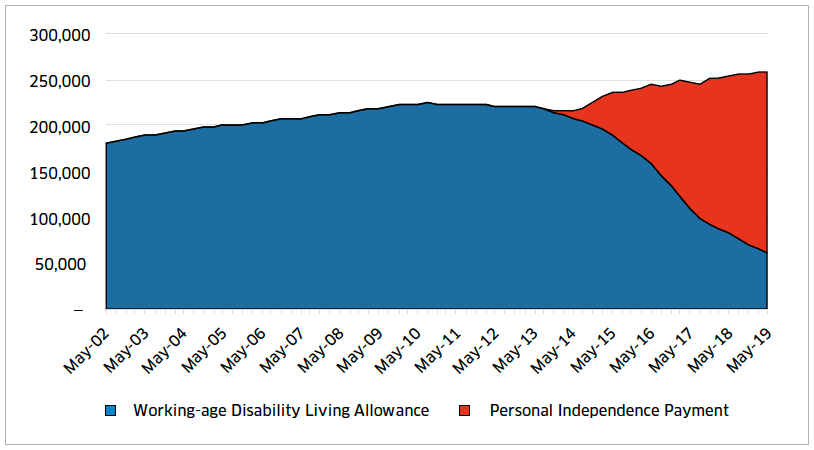
Source: DWP Stat-Xplore
Over the coming years PIP is estimated to become the largest benefit administered by the Scottish Government, both by expenditure and by the number of people receiving the benefit. The Scottish Fiscal Commission (SFC) estimate that the number of people claiming PIP will almost double to around 357,000 in 2024/25, from 196,000 in May 2019. Figure 2 presents the SFC’s forecasted caseload for the three largest disability benefits being devolved to Scottish Government: PIP, DLA and Attendance Allowance (AA).
Figure 2 – Forecasted number of PIP, DLA and AA claimants in Scotland
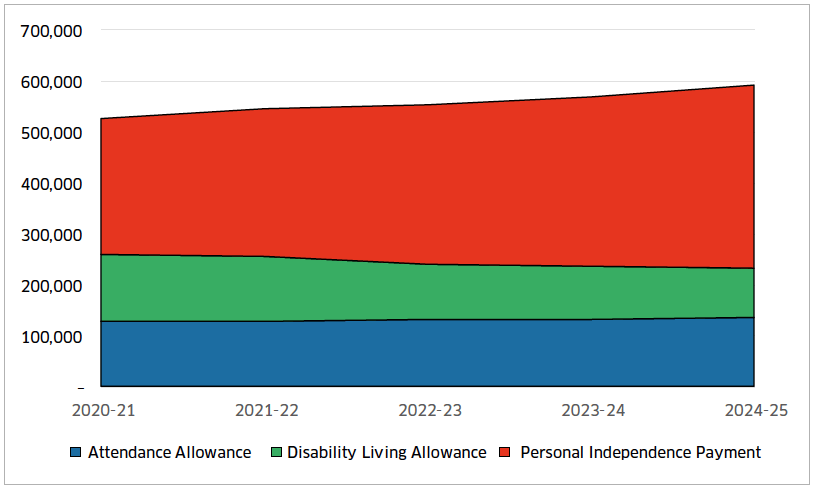
Source: Scottish Fiscal Commission estimates, May 2019[27]
3.1 The cost to Government of Personal Independence Payment
The cost of running PIP has continually exceeded estimates. Like other policies introduced in the UK’s 2012 Welfare Reform Act, such as Universal Credit and the Benefit Cap, PIP was initially expected to reduce social security spending.
The Office for Budget Responsibility’s December 2012 estimate of the impact of PIP predicted that by May 2018, the switch from working-age DLA to PIP would save £2.8 billion per year in UK welfare spending[28]. However, in 2019 the Office for Budget Responsibility (OBR) estimated that PIP has, and will, cost substantially more than it would have to continue DLA. The OBR estimated that continuing working-age DLA across the UK since 2013, rather than implementing PIP, would have cost around £9.5 billion in 2018/19. Instead, by rolling out PIP, the DWP now forecast they will spend £11.6 billion[29].
We have estimated that PIP has also cost much more than expected in Scotland. A Scottish share of the OBR’s original PIP cost forecast in December 2012 places the cost of PIP in Scotland at £810 million in 2017/18[30]. Forecasts from the OBR’s report in January 2019 show that, in fact, PIP spending in Scotland was around £930 million.
As more information becomes available, the estimated cost of PIP has increased with each round of OBR forecasts. Despite a slower than expected rollout of PIP, the actual cost of the policy has continually surpassed these estimates, as shown in Figure 3.
Figure 3 - Estimated and outturn cumulative PIP spending in Scotland, by date of OBR forecast
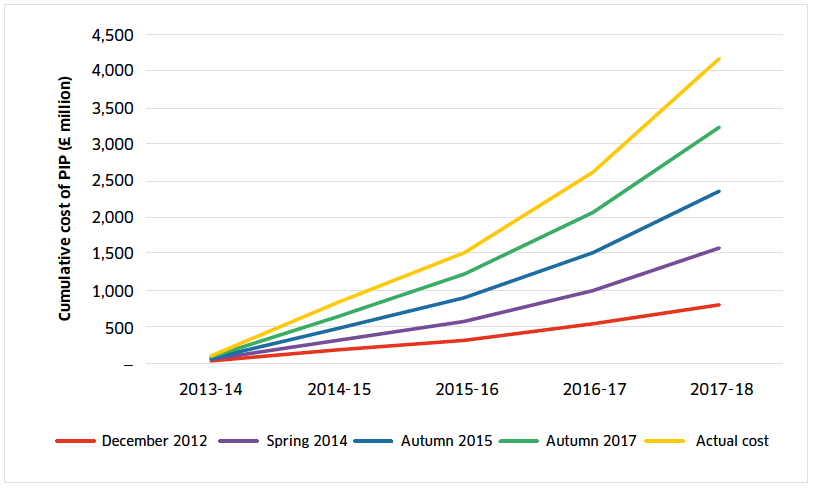
Source: Scottish Government calculations, based on OBR Welfare Trends Report – January 2019 background data
The OBR’s initial spending estimate in December 2012 was underpinned by one key study, the results of which would not later be matched by outturn data. In this study the DWP conducted a test of draft PIP assessment criteria on 900 volunteer DLA claimants. The results suggested PIP would be a much more difficult benefit to claim than DLA, leading to a PIP caseload with 600,000 fewer claimants than working-age DLA. For example, the test suggested that only 35% of new PIP claims would be successful.
Once PIP rollout began, outturn data provided a stronger evidence base which allowed the OBR to improve the accuracy of their forecast. The most recent Welfare Trends Report, published by OBR in December 2019, explains that in practice the success rate of PIP claims has not been quite as low as originally anticipated during its design, while the number of new claims for the benefit has been higher than expected[31]. The report explains that average awards were also higher than expected, in large part because a higher-than-expected share of the PIP caseload received a care component in their award. This is because PIP does not include an equivalent to DLA’s lowest care rate, which was expected to reduce the benefit caseload as people with less serious care requirements ceased to qualify. However, OBR report that instead this appears to have led to more PIP cases being awarded the equivalent of DLA’s middle care rate.
3.2 Claim success rates in the transition from DLA to PIP
The DWP is currently undergoing the process of migrating working-age DLA claimants onto PIP. People who receive DLA will not automatically receive PIP entitlement when they are moved over, but are reassessed to check whether they fit the new PIP award criteria. Since the rollout of PIP, official statistics show that 25% of people undergoing their reassessment in Scotland have lost their disability benefit entitlement entirely[32]. In total, 39,000 people have lost entitlement to disability benefits, representing a minimum loss per claimant of £1,200 per year, scaling up to £7,740 per year, depending on which elements of DLA they were entitled to[33]. As of May 2019 there were 61,000 working-age DLA claimants in Scotland. Given that 25% of people who have gone through reassessment lost entitlement, then historic trends suggest around 16,000 of these 61,000 DLA claimants could lose entitlement during the reassessment process.
While many people have lost DLA through reassessments, the success rate for new claims is in fact far lower. More than half of new claims to PIP are unsuccessful and thus far 167,000 unsuccessful new claims to PIP have been made across Scotland. That means that despite representing 67% of all assessments, new claims represent only 56% of PIP awards while accounting for 81% of all claims which are refused, or ‘disallowed’.
3.3 Award increases and decreases when moving from DLA to PIP
As discussed above, people can lose out during the PIP transition by having their disability benefit entitlement end because they do not fit the stricter PIP award criteria. However, many more people have lost entitlement by receiving a lower award under PIP than they did under DLA. This section summarises the available evidence on the number of people gaining (through receiving a higher award) and losing entitlement (by receiving a reduced award, or having their entitlement end altogether) in the transition from DLA onto PIP[34]. Across Scotland, the number of people gaining or losing entitlement from the reassessment process is fairly evenly split, as shown by Figure 4.
Figure 4 – Number of people in Scotland gaining or losing from DLA to PIP transition between 2013 and 2018
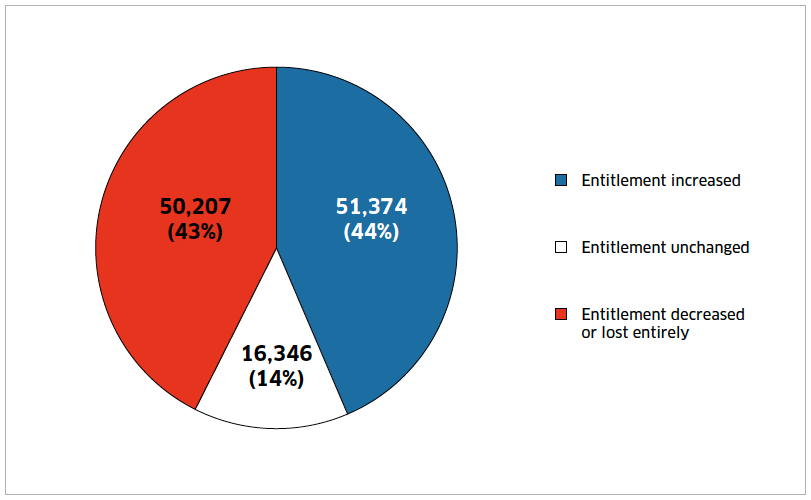
Source: DWP PIP Statistics[35]
Of people being reassessed in Scotland, 44% were eventually entitled to a higher PIP award than they received on DLA, while 43% lost entitlement or saw their entitlement decreased. This 43% failure rate of PIP claims in Scotland is somewhat lower than across the rest of Great Britain, where 46% of reassessments result in a decreased or entirely lost award. Finally, 14% of claimants experienced no change in their entitlement during the transition.
3.3.1 Award increases and decreases by age group
Official data on the number of people gaining or losing entitlement by age group, gender and health condition are unavailable at Scotland level. However, reviewing the available Great Britain-level data can indicate the likely trends in Scotland. These data consistently show that the younger the person in receipt of DLA, the more likely they have been to receive less after the transition to PIP, as shown in Figure 5.
Figure 5 – Proportion of people in Great Britain gaining or losing from DLA to PIP transition, by age group, between 2013 and 2018
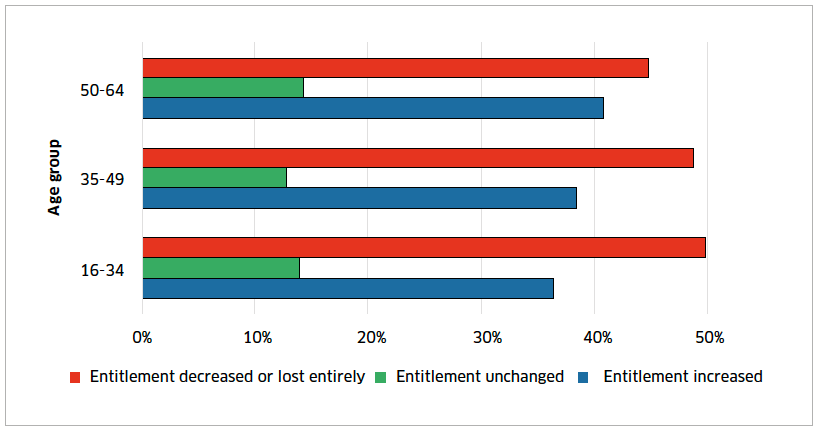
Source: DWP PIP Statistics
Regardless of age group, across Great Britain people transitioning from DLA to PIP are more likely to see their award decreased or lost than increased. However, the risk of decreased income is most pronounced for adults aged under 35. Among this age group 50% saw their award reduce or lost entitlement entirely, compared to only 36% being awarded more.
3.3.2 Award increases and decreases by gender
Across Great Britain women have been more likely to lose entitlement during the PIP transition than men, as shown by Figure 6.
Figure 6 – Proportion of people in Great Britain gaining or losing from DLA to PIP transition, by gender, between 2013 and 2018
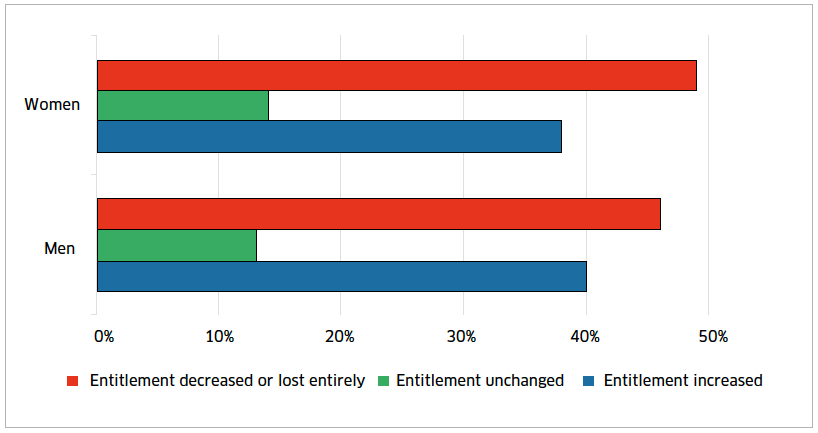
Source: DWP PIP Statistics
Although both male and female DLA claimants are more likely to lose than gain entitlement, women are more likely to lose entitlement than men. Across Great Britain women were 29% more likely to lose entitlement than gain it, while men were 15% more likely to lose than gain.
3.3.3 Award increases and decreases by health condition
Figure 7 summarises the outcome of DLA to PIP transition across Great Britain, this time broken down by each claimant’s main disabling condition as recorded in the claimant’s pre-existing DLA award.
Figure 7 – Proportion of people in Great Britain gaining or losing from DLA to PIP transition, by health condition, between 2013 and 2018
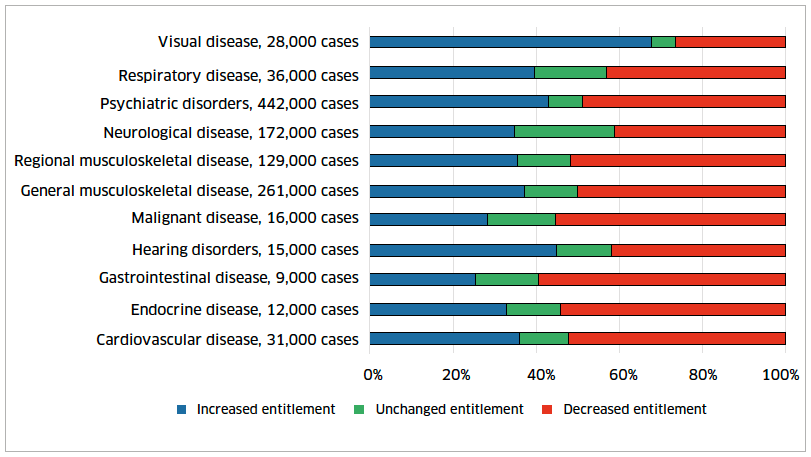
Source: DWP PIP Statistics[36]
As shown above, people with impaired sight have, on average, tended to benefit from moving to PIP – around two thirds will receive higher payments from PIP than they did from DLA. People with impaired hearing have also been more likely to gain than to lose from the transition - 45% gained entitlement while 42% lost. However the picture is quite different for people who suffer from other common types of disease. The data show that, across Great Britain, the transition to PIP has caused:
- 56% of claimants with malignant diseases (such as cancer) to lose income, representing 9,000 people.
- Over half of claimants with musculoskeletal diseases (such as arthritis) to lose income, representing 197,000 people.
- 41% of claimants with neurological diseases (such as epilepsy) to lose income, representing 71,000 people[37].
- 49% of claimants with psychiatric disorders (such as attention deficit hyperactivity disorder) to lose income, representing 216,000 people[38].
3.4 Mandatory Reconsideration and tribunal outcomes
PIP claimants may choose to make an appeal if, for example, they feel they have been incorrectly refused entitlement or if they feel they should have received a higher award.
Where PIP claimants feel the DWP did not make the right decision on their award, they must first ask for the DWP to review their decision. This is called Mandatory Reconsideration (MR). Once the MR decision has been made, either in the claimant’s favour or not, claimants are then entitled to lodge a further appeal, with the aim of having DWP’s decision overturned at an independent tribunal. Figure 8 shows the outcome of PIP assessments (including both new claims and reassessments) in Scotland over the six years to June 2019, how many of these later led to an appeal, and what the final outcome was[39].
Figure 8 – PIP assessment and appeal outcomes in Scotland between April 2013 and June 2019
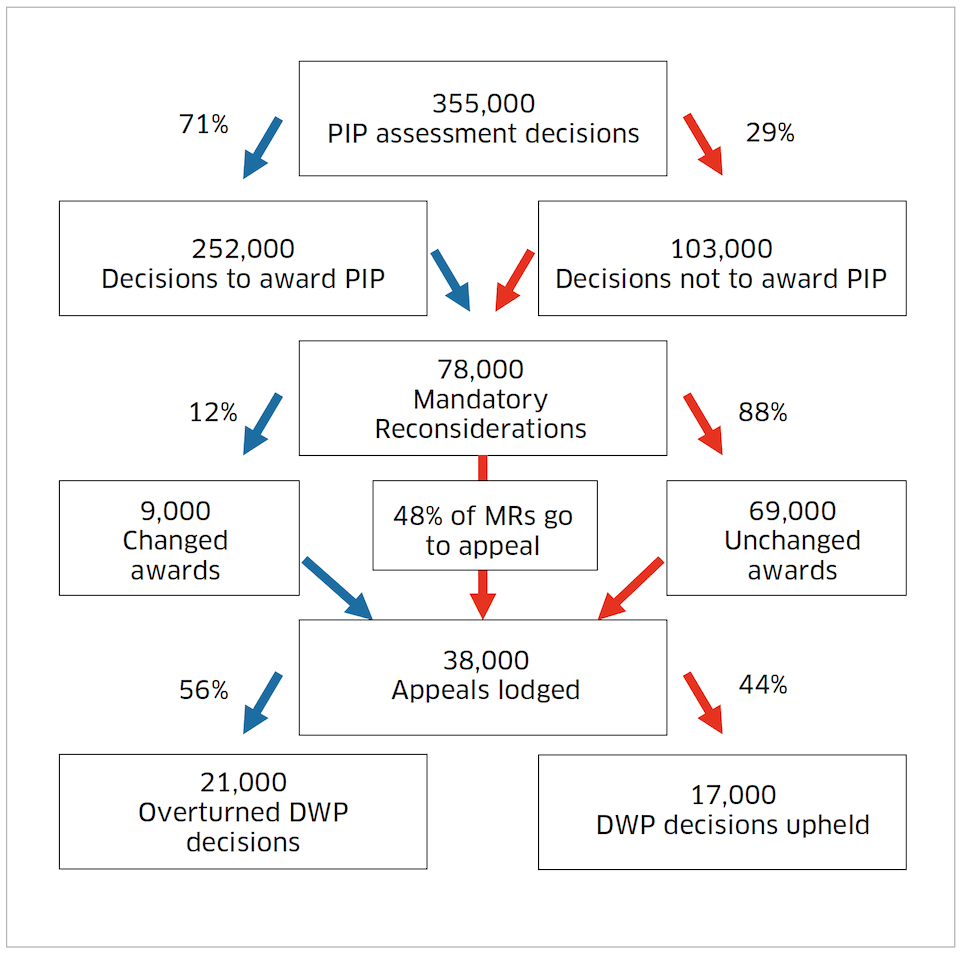
Source: DWP PIP statistics[40]
With 71% of PIP decisions leading to an award, Scotland actually has a higher award success rate than any country in Great Britain, or any of the regions of England. However, of all these geographical areas Scotland also has the lowest success rate of MR decisions, at 12%. Scotland also has the highest number of appeals lodged as a share of total MRs registered – at 48% this is more than 5% higher than the equivalent rate in Wales, or any region of England. Although 56% may seem to be a relatively high success rate of appeals, this is in fact lower than most other regions of Great Britain, where the success rate of appeals is often even higher.
Taken together, this evidence suggests that there have been 30,000 cases in Scotland where claimants have undergone an appeal process in order to receive their correct entitlement. Importantly, tribunal decisions indicate that in 21,000 cases the DWP made an incorrect decision twice, i.e. despite having had the opportunity to reconsider the decision.
Whilst not available for Scotland, Great Britain level data on claimant success rates at initial assessment, MR and appeals over time provide useful insights. Figure 9 shows what proportion of assessment, MR and tribunal decisions were made in the claimant’s favour for new claims in each year since 2013/14.
Figure 9 – Success rates of assessments, MRs and tribunal appeals for new claims across Great Britain, by year, with trend lines showing change over time
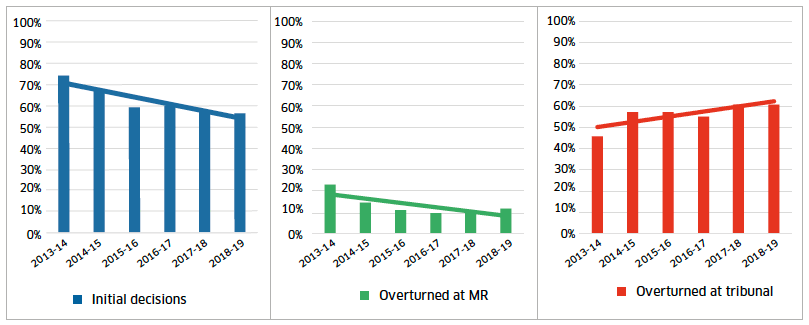
Source: DWP PIP statistics
Figure 9 shows the average change over time in the success rate of each type of decision. For new claims, it is clear that claimant success rate at initial decision, and during the DWP’s MR decision, are declining over time. Conversely, tribunal success rate has broadly increased over time. This would suggest that over time the DWP has been rejecting a greater proportion of new claims. Meanwhile, tribunal courts are finding in favour of the claimant, and against the two earlier DWP decisions, in an increasing share of the tribunal cases presented to them.
Figure 10 presents the equivalent figures for reassessment decisions of claimants moving onto PIP from DLA, beginning in 2014/15 due to the small number of reassessed claims in 2013/14.
Figure 10 - Success rates of reassessed claim assessments, MRs and tribunal appeals across Great Britain, by year, with trend lines showing change over time
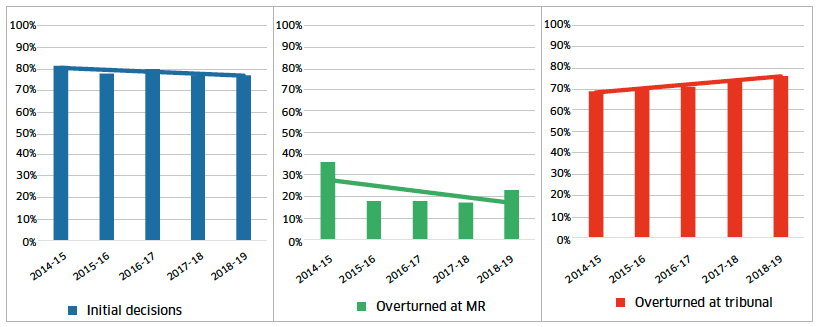
Source: DWP PIP statistics
A similar, although less pronounced trend is visible when examining the success rates of reassessment cases over time. On average, success rate at initial decision has declined moderately over the five years, while MR success rates are also somewhat lower than they were at their peak in 2014/15. Like new claims, success rate at appeal is increasing over time, suggesting that tribunals are increasingly likely to find that DWP made an incorrect decision.
3.5 Lived experience of UK Government disability benefits
This section examines the available evidence on claimants’ lived experience to gain more insight into people’s views of the disability benefit system.
As part of its programme to prepare for taking on responsibility for social security benefits, the Scottish Government has set up Social Security Experience Panels to better understand the needs, experiences and views of benefit claimants. Over 2,400 participants with recent experience of DWP benefits have registered as panel members[41].
The DWP has also undertaken two surveys to explore disabled claimants’ experiences of the system and the PIP claim process. The DWP claimant service and experience survey[42] provides a high-level view of overall claimant satisfaction. This survey shows that the majority (89%) of respondents who did not have a disability were satisfied with the service DWP provided. Although the majority of disabled respondents were also satisfied, disabled people were almost twice as likely to report they were not (only 80% of disabled people reported satisfaction with the DWP service).
The DWP PIP claimant experience survey[43] provides a more detailed view of claimants’ experiences of specific areas of the PIP system, such as how they felt about the application, assessment and appeal processes.
In understanding why claimants of disability benefits are less likely to be satisfied with the benefit system, the available evidence from lived experiences points towards several key issues. We have summarised the issues as: a system that causes stress and anxiety for claimants; a lack of trust in the benefits system; complex or unsuitable application processes; and a lack of help and communication. Evidence discussed in the remainder of the section is taken from two main sources:
1. Scottish Government Experience Panel results[44]
2. DWP 2018 PIP claimant experience survey[45]
BOX A: A system that causes stress and anxiety for claimants
The most concerning aspect of the feedback gathered from the Scottish Government’s Experience Panels is the level of stress and worry that the process of claiming disability benefits can cause. Some participants suggested that the stress from the process can leave people feeling “suicidal”. One participant said:
“I spend from the time I write any form to the time I get the response on my knees mentally with fear, anxiety and stress.”
Comparable information is not available in the DWP’s PIP claimant experience survey as it does not include questions on whether the application process can cause stress and anxiety. Nonetheless, only 14% of survey respondents said that completing the PIP claim form was easier than they expected. A further 49% found the experience as difficult as they expected, and 34% found it more difficult than expected.
Many Experience Panels participants identified the health assessment stage of the process as particularly stressful – some participants called the assessments degrading and humiliating. Reasons for this stress include claimants having little or no control over the assessment’s time and location, poor transport links to the assessment centre and assessment centres not being fully accessible. Some participants stated the assessor themselves made inappropriate comments, for example:
“[The assessor] didn’t agree my daughter had problems using the toilet as she didn’t wet/soil herself in the interview.”
A number of Experience Panels participants specifically identified the appeals process as a source of stress. Improving the appeals process was the third most common priority identified for improvement of the benefit system and was mentioned by 45% of respondents. Some claimants identified a fear of losing the benefit they had already been awarded as a reason why they declined to appeal. One participant said:
“I know their decision is wrong, but do not have the time nor capacity to fight this further - I need to spend all my time / energy caring for her. The appeal stage beyond mandatory reconsideration is too complex and stressful and I feared losing what I already had.”
The DWP’s PIP claimant experience survey also identifies stress as the most important factor in why people declined to appeal their PIP award – 37% felt the process would be too stressful to continue. Some survey respondents provided additional information, stating that the stress and anxiety of the appeal process could make their condition worse, and that they did not feel they had the physical and emotional energy it would take to see the appeals process through.
BOX B: A lack of trust in the benefits system
The Scottish Government’s Experience Panels survey revealed that some participants not only distrusted the benefits system, but also felt distrusted by DWP staff, and went through the process of claiming disability benefits while feeling as if they were “on trial”. Some Experience Panel participants felt that the disability benefit assessment process presented incentives for assessors to disallow claimants in order to help the government to reduce costs.
MRs were specifically described by one participant as a tick-box exercise with little or no prospect of success, which can delay the claimant’s appeal. Other participants felt that DWP staff were unlikely to disagree with their colleague’s assessments, and MRs simply added to the length and stress of the appeal process.
A number of Experience Panels participants highlighted how important it is for DWP staff to have a good working understanding of how disability can affect people. One participant explicitly pointed to the difference that having a good assessor made to their claim:
“The assessor who came to assess my son for his PIP understood his condition and helped him through the assessment by her attitude - she stood out amongst everyone else I have had to deal with.”
However, many felt that assessors did not have a sufficient level of knowledge of their particular health condition to make an accurate assessment. They said that this led the assessors to ask inappropriate questions, caused stress for applicants and left the claimants less confident of receiving an accurate, fair and thorough assessment. One participant said:
“I have attended PIP interviews with my children and been appalled at how little the person knew about their conditions. They wrote ridiculous comments on the report.”
Participants in the DWP’s PIP claimant experience survey reported that a lack of trust in DWP to provide impartial advice was one of the reasons for not requesting help with their application from DWP. This was more pronounced during the MR and appeals process.
BOX C: A complex and unsuitable application process
Of the Scottish Government’s Experience Panels participants, 52% stated that the process of applying for a benefit was an important area for improvement. Feedback from PIP claimants highlighted the complexity of the process, such as:
“P.I.P form is nearly 40 pages and very complicated. I was able to get help from somebody from Citizens Advice. Without their help I wouldn’t have been able to apply successfully.”
The length and repetitiveness of the form was also highlighted, with the nature of some claimant’s disabilities making it difficult for them to complete the forms provided. One claimant replied:
“As my MS progresses, I find writing and typing increasingly difficult. The thought of having to fill out a PIP form yet again next year fills me with dread.”
A further concern was the inability of application forms to take into consideration the individuality of each person’s condition. Experience Panels participants said it was difficult to explain invisible health conditions, or conditions which come and go. One participant stated:
“Long phone calls & forms. If you do not fit into the set categories or your disability is hidden, you miss out on help. Perhaps things could be simplified and claimants not automatically assumed to be lying if a disability is not obvious.”
For face-to-face assessments, the majority of respondents to the DWP’s PIP claimant experience survey were satisfied with their assessment’s time and location. However, significant numbers of respondents were not - 31% of claimants felt the assessment was not in a location they could get to easily and 13% felt that the assessment venue was not accessible.
Many Experience Panels participants pointed out that travelling to an in-person health assessment was difficult because of their health condition. Some reported that the location picked for their assessment was not suitable for a variety of reasons e.g. because they were asked to travel an unreasonably long distance, or suitable parking was unavailable at the assessment centre.
Many respondents to the PIP claimant experience survey reported that the assessor did not ask them pertinent questions about how their illness affects them. For example, only around 40% said the assessor asked if they can repeat activities, while only around 60% said the assessor asked whether they can carry activities out safely. Although 72% of respondents felt the assessor listened to what they had to say, 22% felt that the assessor did not, and the same proportion stated that the assessor did not understand their application form and supporting evidence.
BOX D: A lack of help and communication
The Scottish Government’s Experience Panels survey flagged the need for better advice and support when claiming benefits as the number one priority for improvement of the benefits system, having been identified by 71% of survey participants. More specifically, participants mentioned having issues with the clarity of letters received from the DWP, while others found the letters threatening. Several respondents noted the difficulty of reaching DWP over the phone, adding that the cost of the call is prohibitive for people on low incomes. Many participants had difficulty finding clear and understandable information about what benefits they were entitled to. One Experience Panels participant said:
“..we were unaware my father was entitled to attendance allowance until a nurse informed him. He was lucky to have assistance to fill in the form through help at the Maggie’s Centre. I know he would not have done this without help.”
The DWP’s PIP claimant experiences survey found that over half (59%) of claimants required help completing the application form. However, of those looking for help, only 2% would choose to get help from the DWP.
The same survey found that when respondents received their decision letter, 50% thought it contained the right amount of detail, 26% thought it contained too little detail, while a further 21% thought it focused on the wrong kind of detail. Although a majority of claimants said they had at least some partial understanding, only 41% fully understood how DWP had reached their award decision, while 43% fully understood how the evidence they had provided to the DWP was taken into account. For example, only 19% of respondents said their decision letter referred to medical evidence, while 56% said it had not. Among the 32% of respondents who sought help in understanding the decision letter, only 23% decided to contact the DWP. Of those who contacted the DWP, 51% said that contacting the DWP did not give them a clearer understanding of the decision.
3.6 DWP Administrative exercise to identify underpaid claimants
This section focuses on two Upper Tribunal decisions which went against the UK Government. As a result of these decisions the DWP was required to undergo an administrative exercise to identify PIP claimants who have been wrongfully underpaid or excluded from PIP[46].
The first relates to the decision of the England and Wales High Court that it is unlawful for DWP to treat claimants differently when their mobility problems are caused by mental, rather than physical, health conditions. Before this judgement, the DWP mobility descriptors, which are used to determine a claimant’s level of entitlement, meant that claimants could receive a lower entitlement if their mobility issues were caused by ‘overwhelming psychological distress’[47]. In his finding against the Secretary of State for Work and Pensions, Mr Justice Mostyn referenced the UK Government’s defence that treating mental health conditions similarly to physical conditions could have “serious costs consequences”, stating:
“In my judgement, the 2017 regulations introduced (and I emphasise introduced) criteria to descriptors c, d and f, which were blatantly discriminatory against those with mental health impairments and which cannot be objectively justified. The wish to save nearly 1 billion a year at the expense of those with mental health impairments is not a reasonable foundation for passing this measure[48].”
The second decision relates to the ability of PIP claimants to undertake activities safely[49]. During the tribunal, the counsel representing the Secretary of State contended that PIP regulations meant that a claimant can be considered able to undertake an activity safely, unless it is “more likely than not” to cause them to suffer harm[50]. The tribunal judgement, however, disagreed, stating that:
“An assessment that an activity cannot be carried out safely does not require that the occurrence of harm is “more likely than not”.”
Because the court judgements both applied retrospectively, the DWP was required to identify claimants who may have been underpaid. As a result, the then Minister for Disabled People, Health and Work announced an exercise would be launched to review the cases of all people claiming PIP at that time, totalling 1.6 million claimants[51]. It was initially announced that an estimated 220,000 people could be affected by the judgement, and that the costs of implementing the exercise could be up to £3.7 billion by 2022/23. With 220,000 people affected from a caseload of 1.6 million, this would suggest that around 1 in every 7 claimants could be affected.
However, recent statistics published by the DWP show that in fact, out of 440,000 reviewed cases, only 3,500 arrears payments have been made, with an average value of £4,500 each[52]. This suggests that so far the exercise has only issued a back payment to around 1 in every 125 cases reviewed, far fewer than the 1 in 7 estimated to be affected during the announcement of the exercise.
Contact
Email: Jamie.Hume@gov.scot
There is a problem
Thanks for your feedback